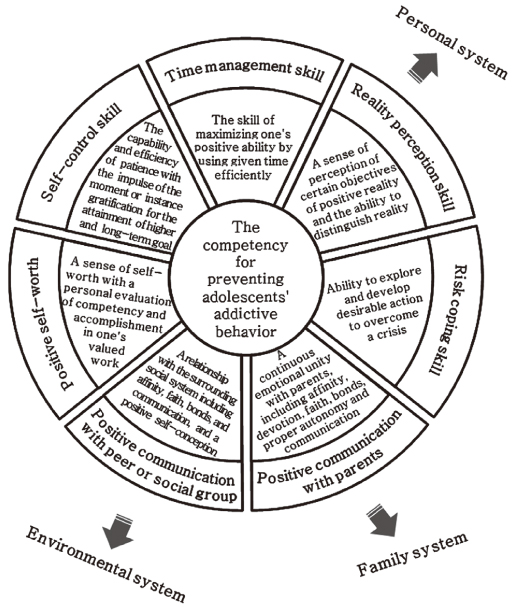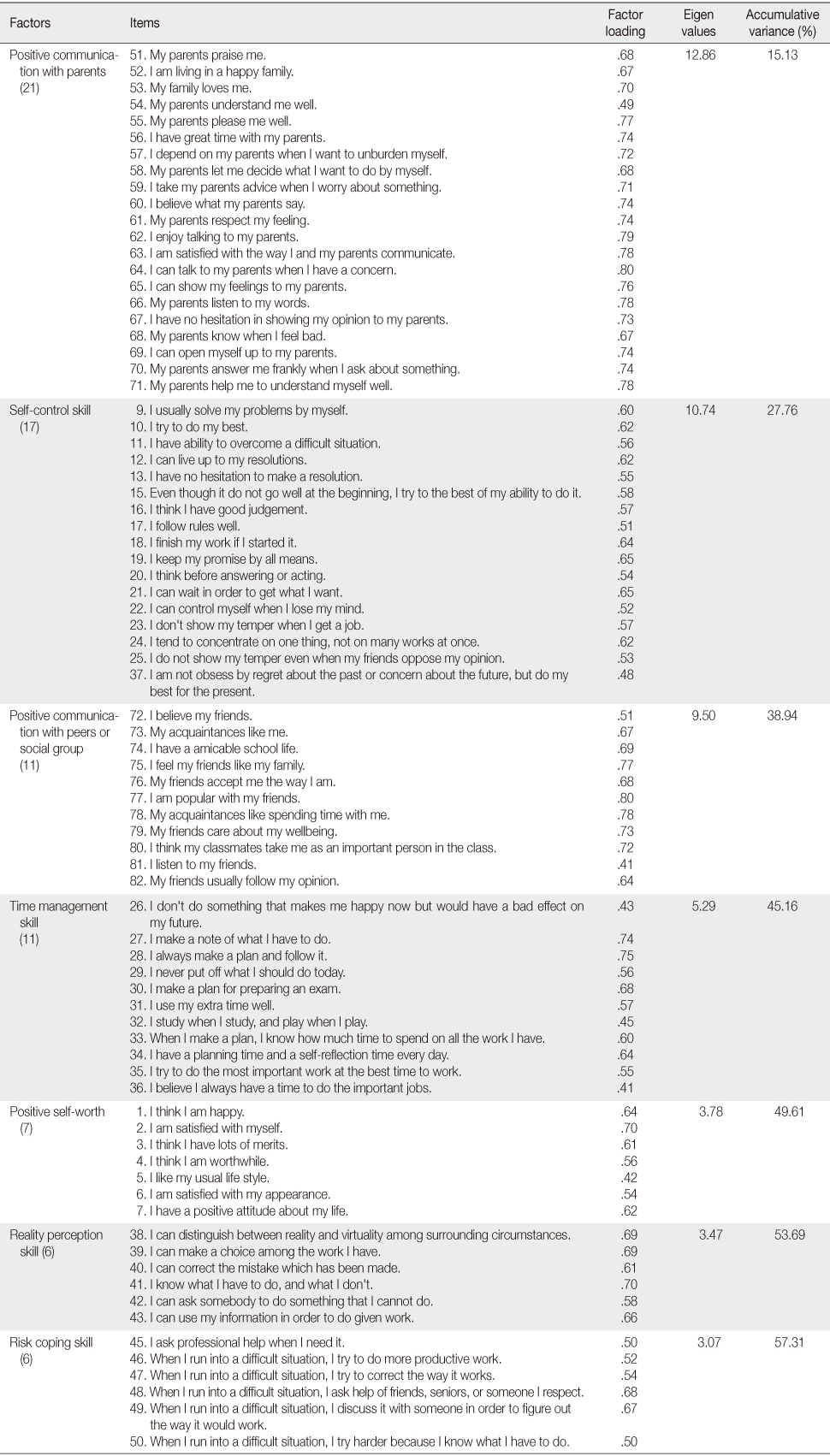Articles
- Page Path
- HOME > J Korean Acad Nurs > Volume 43(6); 2013 > Article
-
Original Article
- Construction of the Addiction Prevention Core Competency Model for Preventing Addictive Behavior in Adolescents
- Hyun Sook Park, Sun Young Jung
-
Journal of Korean Academy of Nursing 2013;43(6):714-725.
DOI: https://doi.org/10.4040/jkan.2013.43.6.714
Published online: December 31, 2013
College of Nursing, The Research Institute of Nursing Science, Catholic University of Daegu, Daegu, Korea.
- Address reprint requests to: Jung, Sun Young. College of Nursing, Catholic University of Daegu, 3056-6 Daemyeong 4-dong, Nam-gu, Daegu 705-718, Korea. Tel: +82-53-650-4977, Fax: +82-53-650-4392, jungsy@cu.ac.kr
• Received: August 7, 2013 • Accepted: October 18, 2013
© 2013 Korean Society of Nursing Science
Abstract
-
Purpose
- This study was done to provide fundamental data for the development of competency reinforcement programs to prevent addictive behavior in adolescents through the construction and examination of an addiction prevention core competency model.
-
Methods
- In this study core competencies for preventing addictive behavior in adolescents through competency modeling were identified, and the addiction prevention core competency model was developed. It was validated methodologically.
-
Results
- Competencies for preventing addictive behavior in adolescents as defined by the addiction prevention core competency model are as follows: positive self-worth, self-control skill, time management skill, reality perception skill, risk coping skill, and positive communication with parents and with peers or social group. After construction, concurrent cross validation of the addiction prevention core competency model showed that this model was appropriate.
-
Conclusion
- The study results indicate that the addiction prevention core competency model for the prevention of addictive behavior in adolescents through competency modeling can be used as a foundation for an integral approach to enhance adolescent is used as an adjective and prevent addictive behavior. This approach can be a school-centered, cost-efficient strategy which not only reduces addictive behavior in adolescents, but also improves the quality of their resources.
This study was supported by the National Research Foundation of Korea fund in 2011 (NRF-2011-0014636).
- 1. Chambers RA, Potenza MN. Neurodevelopment, impulsivity, and adolescent gambling. J Gambl Stud. 2003;19(1):53–84. http://dx.doi.org/10.1023/A:1021275130071ArticlePubMedPDF
- 2. Chen AC. What do we know about adolescent risky sexual behavior: A multi-level environmental approach. Seattle, WA, University of Washington. 2004;Unpublished doctoral dissertation.
- 3. Choi YS, Choi HJ, Ahn YJ. The effect of parents' raising attitude, self-control, and peer relationship on adolescents' internet addiction. J Fam Relat. 2011;15(4):113–133.
- 4. Coombs RH. Handbook of addictive disorders: A practical guide to diagnosis and treatment. Hoboken, NJ: John Wiley & Sons; 2004.
- 5. Freeman H, Brown BB. Primary attachment to parents and peers during adolescence: Differences by attachment style. J Youth Adolesc. 2001;30(6):653–674. http://dx.doi.org/10.1023/A:1012200511045ArticlePDF
- 6. Guerra NG, Bradshaw CP. Linking the prevention of problem behaviors and positive youth development: Core competencies for positive youth development and risk prevention. New Dir Child Adolesc Dev. 2008;2008(122):1–17. http://dx.doi.org/10.1002/cd.225Article
- 7. Gutman SA. Why addiction has a chronic, relapsing course. The neurobiology of addiction: Implications for occupational therapy practice. Occup Ther Ment Health. 2006;22(2):1–29. http://dx.doi.org/10.1300/J004v22n02_0
- 8. Ha JH, Lee HK. The effects of optimism, self-efficacy in the real life, self-efficacy in the cyber-space, hardiness, internet immersion, on adolescents' internet addiction. Korean J Couns. 2005;6(3):919–932.
- 9. Haegerich TM, Tolan PH. Core competencies and the prevention of adolescent substance use. New Dir Child Adolesc Dev. 2008;2008(122):47–60. http://dx.doi.org/10.1002/cd.228ArticlePubMed
- 10. Hagedorn WB. Sexual addiction counseling competencies: Empirically-based tools for preparing clinicians to recognize, assess, andtreat sexual addiction. Sex Addict Compulsivity. 2009;16(3):190–209. http://dx.doi.org/10.1080/10720160903202604Article
- 11. Haugaard JJ. Problematic behavior during adolescence. Boston, MA: McGraw-Hill; 2001.
- 12. Henggeler SW. The family-ecological system theory. In: Henggeler SW, editor. Delinquency and adolescent psychopathology: A family-ecological systems approach. Boston, MA: John Wright; 1982. p. 1–10.
- 13. Hollander E, Allen A. Is compulsive buying a real disorder, and is it really compulsive? Am J Psychiatry. 2006;163(10):1670–1672. http://dx.doi.org/10.1176/appi.ajp.163.10.1670ArticlePubMed
- 14. Hwang HS, Park SB. The impact of user's psychological experience on online game addiction: Perceived reality and sense of presence. J Commun Sci. 2008;11(1):474–510.
- 15. Kim EK. The development of nursing leadership competency model. Seoul, Korea National Defense University. 2006;Unpublished master's thesis.
- 16. Kim KH. A way to overcome addiction, the modern dungeon. Korean J Health Psychol. 2007;12(4):677–693.
- 17. Ledgerwood DM, Downey KK. Relationship between problem gambling and substance use in a methadone maintenance population. Addict Behav. 2002;27(4):483–491.ArticlePubMed
- 18. Lee HS. Patterns of impulsiveness. J Humanit. 1994;21:93–104.
- 19. Lee HS. Korean version Eysenck personality questionnaire. Seoul: Hakjisa; 1997.
- 20. Lee KB. A study of the developmental solutions of youth activities programs in the development of youth capabilities. Forum Youth Cult. 2009;20:172–212.
- 21. National Information Society Agency. A study on the trend of internet addiction and legislation (No. Research 07-15). Seoul: Author; 2008.01.
- 22. Park HS, Jung SY. Development of the competency model for prevention of adolescent risk behavior. J Korean Acad Nurs. 2011a;41(2):204–213. http://dx.doi.org/10.4040/jkan.2011.41.2.204ArticlePubMed
- 23. Park HS, Jung SY. Validation of addictive personality scale for screening adolescents. J Korean Acad Psychiatr Ment Health Nurs. 2011b;20(4):395–403.Article
- 24. Rankin BH, Quane JM. Social contexts and urban adolescent outcomes: The interrelated effects of neighborhoods, families, and peers on African-American youth. Soc Probl. 2002;49(1):79–100.Article
- 25. Ryu CS. SPSS 14.0 for windows. 5th ed. Seoul: Elite; 2006.
- 26. Seligman ME, Steen TA, Park N, Peterson C. Positive psychology progress: Empirical validation of interventions. Am Psychol. 2005;60(5):410–421. http://dx.doi.org/10.1037/0003-066-x.60.5.410ArticlePubMed
- 27. Song H, Thompson RA, Ferrer E. Attachment and self-evaluation in Chinese adolescents: Age and gender differences. J Adolesc. 2009;32(5):1267–1286. http://dx.doi.org/10.1016/j.adolescence.2009.01.001ArticlePubMedPDF
- 28. Spencer LM, Spencer SM. Min BM Park DG Park JK Jeong JC . Competence at work: Models for superior performance. Seoul: PSI Consulting Corp; 2005.
- 29. Yoon MS. The current situation and developmental direction of Korean addiction service delivery system. Ment Health Soc Work. 2010;35:234–266.
- 30. You YD. The theoretical implications of the flow model for the development of the addiction counselling program. Korean J Youth Couns. 2002;10(2):1–34.
REFERENCES
Figure & Data
REFERENCES
Citations
Citations to this article as recorded by 

- Effects of a Strength Based I-Change Smoking Cessation Program for Smoking Middle School Boys
Jung Hee Kim, Yeon Hee Choi
Journal of Korean Academy of Nursing.2017; 47(2): 164. CrossRef - Health Behaviors and Related Demographic Factors among Korean Adolescents
YunHee Shin, Sook Jung Kang
Asian Nursing Research.2014; 8(2): 150. CrossRef - Predictors of Protective Factors for Internet Game Addiction in Middle School Students using Data Mining Decision Tree Analysis
Young-Ran Kweon, Se-Young Kim
Journal of Korean Academy of Psychiatric and Mental Health Nursing.2014; 23(1): 12. CrossRef - Development of Expert Competency Model for Preventing Adolescent Addictive Behavior and Educational Needs of Psychiatric Mental Health Nurses
Hyun Sook Park, Sun Young Jung
Journal of Korean Academy of Psychiatric and Mental Health Nursing.2014; 23(4): 199. CrossRef
Construction of the Addiction Prevention Core Competency Model for Preventing Addictive Behavior in Adolescents

Figure 1
The competency model for preventing adolescents' addictive behavior.
Figure 1
Construction of the Addiction Prevention Core Competency Model for Preventing Addictive Behavior in Adolescents
Factor Analysis of Final Items (N=861)
Competency due to Level of Crisis (N=258)
Table 1
Factor Analysis of Final Items (N=861)
Table 2
Competency due to Level of Crisis (N=258)
 KSNS
KSNS
 E-SUBMISSION
E-SUBMISSION



 Cite
Cite

